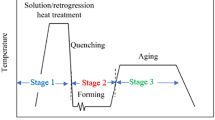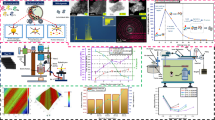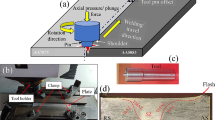Abstract
The effect of alloying addition on the flow behavior of aluminum alloys was investigated. Three compositions were produced for this study including pure aluminum; aluminum–10wt% copper; and aluminum–10wt% copper–5wt% titanium. The bulk samples of these alloys were fabricated by mechanical alloying and hot consolidation. The flow behavior of the alloys under investigation was studied at room temperature by Stress–Strain-Microprobe® system and its Automated Ball Indentation® (ABI®) test method. The ABI experiment results were used to display the behavior of load-versus-depth of indentation (L–D), stress-versus-strain (S–S) behavior, yield strength, ultimate tensile strength, and ABI hardness. Pure aluminum revealed the lowest resistance to penetration and the weakest mechanical strength. The addition of copper to pure Al produced a higher resistance to penetration and augmented alloy strength. Adding Cu and Ti to pure Al exhibited the highest resistance to penetration and the strongest mechanical strength.





Similar content being viewed by others
References
Lee K-M, Moon I-H Mater Sci Eng A185 (1994) 165.
Sasaki T T, Ohkubo T, and Hono K Acta Mater57 (2009) 3529.
Sasaki T T, Mukai T, and Hono K Scr Mater57 (2007) 189.
Krasnowski M, and Kulik T Mater Chem Phys116 (2009) 631.
Haggag F M (1989) US Patent No. 4852397 1 August 1.
Haggag F M, in Small Specimen Test Techniques Applied to Nuclear Reactor Thermal Annealing and Plant Life Extension, ASTM STP 1204, (eds) Corwin W R, Haggag F M, and Server W L, American Society for Testing and Materials, Philadelphia (1993), p 27.
Haggag F M, in Proceedings of the ASM 3rd International Conference on Trends in Welding Research, ASM, (1992), p 629.
Malow T R, Koch C C, Miraglia P Q, and Murty K L Mater Sci Eng A252 (1998) 36.
Dipika R B, Balla A R, Peshwe D R, Ganeshkumar J, Laha K, and Mathew M D Proc Eng86 (2014) 910.
Nagaraju S, GaneshKumar J, Vasantharaja P, Vasudevan M, and Laha K Mater Sci Eng A695 (2017) 199.
Hamada A S, Haggag F M, and Porter D A Mater Sci Eng A558 (2012) 766.
Li B, Zhang S, Li J, Wang J, and Lu S Mater Sci Eng A773 (2020) 138717.
Wang F, Zhao J, Zhu N, and Li Z J Alloys Compd633 (2015) 220.
Patil D C, Das M, Das G, Kori S A, and Venkateswarlu K Proc Mater Sci5 (2014) 379.
Ammar H R, Haggag F M, Alaboodi A S, and Al-Mufadi F A Mater Sci Eng A729 (2018) 477.
Chen H, Cai L, and Bao C Mater Des162 (2019) 322.
Ammar H R Mater Res Express6 (2019) 165f1.
Ammar H R, Haggag F M Trans Nonferrous Met Soc China29 (2019) 2472.
Kulkarni R V, Mani Krishna K V, Neogy S, Srivastava D, Ramadasan E, Dey G K, Saibaba N, Jha S K, Shriwastaw R S, and Anantharaman S Nucl Eng Des265 (2013) 1101.
Sharma K, Singh P K, Bhasin V, and Vaze K K J Min Mater Charact Eng10 (2011) 661.
Acknowledgements
The author is appreciative to Eng. Fahmy Haggag, the president of ABI Services, LLC (USA) for performing the ABI tests on the investigated samples.
Author information
Authors and Affiliations
Corresponding author
Additional information
Publisher's Note
Springer Nature remains neutral with regard to jurisdictional claims in published maps and institutional affiliations.
Rights and permissions
About this article
Cite this article
Ammar, H.R. The Impact of Alloying Elements Addition on the Flow Behavior of Aluminum Alloys. Trans Indian Inst Met 73, 1605–1609 (2020). https://doi.org/10.1007/s12666-020-01935-7
Received:
Accepted:
Published:
Issue Date:
DOI: https://doi.org/10.1007/s12666-020-01935-7




